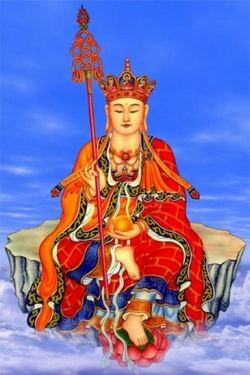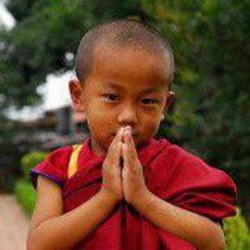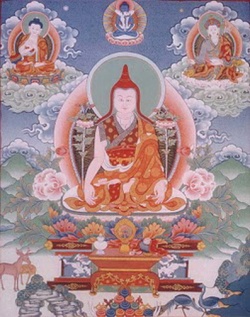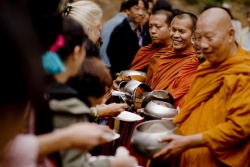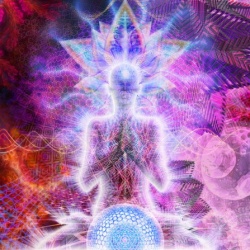The twenty-fourth Buddha, the third of the present neon (the Bhaddakappa) and one of the seven Buddhas mentioned in the Canon
Also called Kassapa Dasabala to distinguish him from other Kassapas.
The twenty-fourth Buddha, the third of the present neon (the Bhaddakappa) and one of the seven Buddhas mentioned in the Canon (D.ii.7).
He was born in Benares, in the Deer Park at Isipatana, of brahmin parents, Brahmadatta and Dhanavatī, belonging to the Kassapagotta.
For two thousand years he lived in the household, in three different palaces, Hamsa, Yasa and Sirinanda.
(The BuA.217 calls the first two palaces Hamsavā and Yasavā).
He had as chief wife Sunandā, by whom he begot a son, Vijitasena.
Kassapa left the world, traveling in his palace (pāsāda), and practiced austerities for only seven days.
Just before his Enlightenment his wife gave him a meal of milk-rice, and a yavapāla named Soma gave him grass for his seat.
His bodhi was a banyan-tree, and he preached his first sermon at Isipatana to a crore of monks who had renounced the world in his company.
He performed the Twin-Miracle at the foot of an asana-tree outside Sundaranagara.
He held only one assembly of his disciples; among his most famous conversions was that of a yakkha, Naradeva (q.v.).
His chief disciples were Tissa and Bhāradvāja among monks, and Anulā and Uruvelā among nuns, his constant attendant being Sabbamitta.
Among his patrons, the most eminent were Sumangala and Ghattīkāra, Vijitasenā and Bhaddā.
His body was twenty cubits high, and, after having lived for twenty thousand years, he died in the Setavya pleasance at Setavyā in Kāsī.
Over his relics was raised a thūpa one league in height, each brick of which was worth one crore.
It is said (MA.i.336ff ) that there was a great difference of opinion as to what should be the size of the thūpa and of what material it should be constructed; when these points were finally settled and the work of building had started, the citizens found they had not enough money to complete it.
Then an anāgāmī devotee, named Sorata, went all over Jambudīpa, enlisting the help of the people for the building of the thūpa.
He sent the money as he received it, and on hearing that the work was completed, he set out to go and worship the thūpa; but he was seized by robbers and killed in the forest, which later came to be known as the Andhavana.
Upavāna, in a previous birth, became the guardian deity of the cetiya, hence his great majesty in his last life (DA.ii.580; for another story of the building of the shrine see DhA.iii.29).
Among the thirty-seven goddesses noticed by Guttila, when he visited heaven, was one who had offered a scented five-spray at the cetiya (J.ii.256).
So did Alāta offer āneja-flowers and obtain a happy rebirth (J.vi.227).
The cause of Mahā-Kaccāna's golden complexion was his gift of a golden brick to the building of Kassapa's shrine (AA.i.116).
At the same cetiya, Anuruddha, who was then a householder in Benares, offered butter and molasses in bowls of brass, which were placed without any interval around the cetiya (AA.i.105).
Among those who attained arahantship under Kassapa is mentioned Gavesī, who, with his five hundred followers, strove always to excel themselves until they attained their goal (A.iii.214ff).
Mahākappina, then a clansman, built, for Kassapa's monks, a parivena with one thousand cells (AA.i.175).
Bakkula's admirable health and great longevity were due to the fact that he had given the first fruits of his harvest to Kassapa's monks (MA.iii.932).
During the time of Kassapa Buddha, the Bodhisatta was a brahmin youth named Jotipāla who, afterwards, coming under the influence of Ghatīkāra, became a monk. (Bu.xxv.; BuA.217ff; D.ii.7; J.i.43, 94; D.iii.196; Mtu.i.303ff, 319).
This Ghatīkāra was later born in the Brahma-world and visited Gotama, after his Enlightenment.
Gotama then reminded him of this past friendship, which Ghatīkāra seemed too modest to mention (S.i.34f).
The Majjhima Nikāya (M.ii.45f ) gives details of the earnestness with which Ghatīkāra worked for Jotipāla's conversion when Kassapa was living at Vehalinga.
The same sutta bears evidence of the great regard Kassapa had for Ghatīkāra.
The king of Benares at the time of Kassapa was Kikī, and the four gateways of Kassapa's cetiya were built, one by Kikī, one by his son Pathavindhara, one by his ministers led by his general, and the last by his subjects with the treasurer at their head (SnA.i.194).
It is said that the Buddha's chief disciple, Tissa, was born on the same day as Kassapa and that they were friends from birth. Tissa left the world earlier and became an ascetic.
When he visited the Buddha after his Enlightenment, he was greatly grieved to learn that the Buddha ate meat (āmagandha), and the Buddha preached to him the Āmagandha Sutta, by which he was converted (SnA.i.280ff).
The Ceylon Chronicles (Mhv.xv.128ff; Sp.i.87; Dpv.xv.55ff; Mbv.129) mention a visit paid by Kassapa to Ceylon in order to stop a war between King Jayanta and his younger brother.
The island was then known as Mandadīpa, with Visāla as capital.
The Buddha came with twenty thousand disciples and stood on Subhakūta, and the armies seeing him stopped the fight. In gratitude, Jayanta presented to the Buddha the Mahāsāgara garden, in which was afterwards planted a branch of the Bodhi-tree brought over by Sudhammā, in accordance with the Buddha's wish.
The Buddha preached at the Asokamālaka, the Sudassanamālaka and the Somanassamālaka, and gave his rain-cloak as a relic to the new converts, for whose spiritual guidance he left behind his disciples Sabbananda and Sudhammā and their followers.
In Kassapa's time Mt. Vepulla at Rājagaha was known as Supassa and its inhabitants as the Suppiyas (S.ii.192).
But many other places had the same names in the time of Kassapa as they had in the present age - e.g., Videha (J.vi.122), Sāvatthi (J.vi.123), Kimbila (J.vi.121) and Bārānasī. (J.vi.120).
Besides the āmagandha Sutta mentioned above, various other teachings are mentioned as having been first promulgated by Kassapa and handed on down to the time of Gotama and re-taught by him.
Such, for instance, are the questions (pucchā) of Ālavaka and Sabhiya and the stanzas taught to Sutasoma by the brahmin Nanda of Takkasilā (J.v.476f; 453).
The Mittavinda Jātaka (No.104) is mentioned as belonging to the days of Kassapa Buddha (J.i.413).
Mention is also made of doctrines which had been taught by Kassapa but forgotten later, and Gotama is asked by those who had heard faint echoes of them to revive them (E.g., MA, i.107, 528; AA.i.423).
A sermon attributed to Kassapa, when he once visited Benares with twenty thousand monks, is included in the story of Pandita-Sāmanera (DhA.ii.127ff).
It was on this occasion that Kassapa accepted alms from the beggar Mahāduggata in preference to those offered by the king and the nobles.
Kassapa held the uposatha only once in six months (DhA.iii.236).
Between the times of Kassapa and Gotama the surface of the earth grew enough to cover Sūkarakata-lena (MA.ii.677).
The records of Chinese pilgrims contain numerous references to places connected with Kassapa.
Hiouien Thsang speaks of a stūpa containing the relics of the whole body of the Buddha, to the north of the town, near Srāvasti, where, according to him, Kassapa was born (Beal, op. cit., ii.13).
Mention is also made of a footprint of Kassapa (Ibid.i., Introd. ciii).
Stories of Kassapa are also found in the Divyāvadāna (E.g., pp.22f; 344f; 346f; see also Mtu., e.g., i.59, 303f).
The Dhammapada Commentary (iii.250f ) contains a story, which seems to indicate that, near the village of Todeyya, there was a shrine thought to be that of Kassapa and held in high honour by the inhabitants of the village.
After the disappearance of Kassapa's Sāsana, a class of monks called Setavattha-samanavamsa ("white-robed recluses") tried to resuscitate it, but without success (VibhA.432)."
